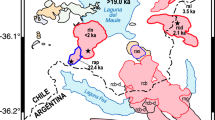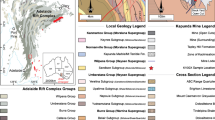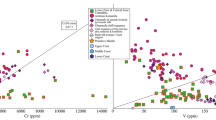Abstract
The Central Iberian Zone of Spain and Portugal contains numerous gold deposits of varying size, age and host lithology. Previous work concentrated on single deposits leading to a need to apply a range of techniques to the region as a whole, to form a model for metallogenesis throughout the region. With this aim, a number of occurrences of gold mineralisation in the south-western Central Iberian Zone were studied. The Central Iberian Zone consists essentially of greenschist facies metasedimentary units intruded by Hercynian granitoids. Hercynian deformation occurred in three main stages, the earliest (D1) being the most intense. Quartz veining is common throughout the region, and a vein chronology was established relative to these deformation events. V1 veins are pre-Hercynian, and may predate the Precambrian Sardic deformation. V2 veins are syndeformational (D1), and associated with peak greenschist metamorphism. V3 veins are late-kinematic, syn- to post-D2. V4 veins are syn- to post-D3, occurring in the final stages of the Hercynian, and often associated with or post-dating granites. Reactivation of vein sets by later fluids was common. Fluid chemistry studies of samples of known chronology indicate three main sources of fluid. The dominant fluid throughout the region from V2 to V4 is a dilute aqueo-carbonic fluid of varying composition. The combination of fluid inclusion analyses and geochemical studies of wallrock alteration indicates that the fluid was the result of devolatilisation and dehydration during prograde metamorphism at varying depths. The resulting aqueo-carbonic fluids flowed upwards, mixing with each other and with meteoric waters. Contact metamorphism associated with granite intrusions during the D3 deformation released further aqueo-carbonic fluids, which in some cases unmixed to form separate carbonic and aqueous inclusions. Circulation of meteoric waters was important during later stages (D3). Prolonged low temperature fluid-rock interaction produced highly saline aqueous fluids which post-date all major quartz veining. No single set of characteristics exists for gold mineralisation in the Central Iberian Zone. Deposits cover a wide spectrum, but three main types have been identified: (1) early (D1/V2) syn-peak metamorphic gold-quartz veins, associated with an aqueo-carbonic fluid with high N2 and CH4; (2) late-kinematic (D2/V3) veins, often associated with late brittle faults. Again, the fluid present at the time of formation was aqueo-carbonic, but with lower N2 and CH4. (3) Late (V4) low temperature veins, formed by a mainly meteoric fluid, which was also responsible for remobilisation and concentration of gold in earlier deposits. The gold mineralisation in the Central Iberian Zone supports the continuum model for lode gold deposits. Gold was leached from metasediments during prograde metamorphism, transported to shallower crustal levels, and deposited wherever suitable traps occurred. Channelling of fluid from deeper levels resulted in the localisation of deposits close to major shear zones. Depositional sites were usually dilational zones in faults, and more rarely folds, but locally lithological controls were important. H2O-CO2 unmixing was common, but was not necessarily related to gold deposition.
Similar content being viewed by others
Author information
Authors and Affiliations
Additional information
Received: 19 February 1996 / Accepted: 11 February 1997
Rights and permissions
About this article
Cite this article
Murphy, P., Roberts, S. Evolution of a metamorphic fluid and its role in lode gold mineralisation in the Central lberian Zone. Mineral. Deposita 32, 459–474 (1997). https://doi.org/10.1007/s001260050115
Issue Date:
DOI: https://doi.org/10.1007/s001260050115




